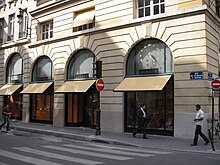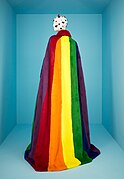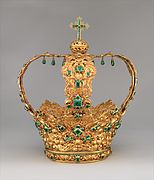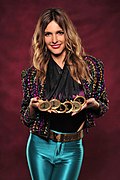
Back بوابة:موضة Arabic প্রবেশদ্বার:ফ্যাশন Bengali/Bangla Portail:Mode French Portale:Moda Italian Portal:ファッション Japanese Портал:Мода Macedonian Portaal:Mode Dutch Portal:Moda Portuguese Портал:Мода Russian
The Fashion Portal
 | |

| |
Fashion is a term used interchangeably to describe the creation of clothing, footwear, accessories, cosmetics, and jewellery of different cultural aesthetics and their mix and match into outfits that depict distinctive ways of dressing (styles and trends) as signifiers of social status, self-expression, and group belonging. As a multifaceted term, fashion describes an industry, styles, aesthetics, and trends.
The term 'fashion' originates from the Latin word 'Facere,' which means 'to make,' and describes the manufacturing, mixing, and wearing of outfits adorned with specific cultural aesthetics, patterns, motifs, shapes, and cuts, allowing people to showcase their group belonging, values, meanings, beliefs, and ways of life. Given the rise in mass production of commodities and clothing at lower prices and global reach, reducing fashion's environmental impact and improving sustainability has become an urgent issue among politicians, brands, and consumers. (Full article...)
Selected article -
Hermès International S.A. (/ɛərˈmɛz/ ⓘ er-MEZ, French: [ɛʁmɛs] ⓘ) is a French luxury fashion house established in 1837. It specializes in leather goods, silk goods, lifestyle accessories, home furnishings, perfumery, jewelry, watches and ready-to-wear. Since the 1950s, its logo has been a depiction of a ducal horse-drawn carriage. (Full article...)
Core topics -
Fashion journalism is a component of fashion media, with a focus on writing and photojournalism. Fashion journalists write about and critique fashion events and trends as well as cultivate and maintain relationships with stylists and designers. Fashion journalists are either employed full-time by a publication, or submit articles on a freelance basis. Fashion photography, which supplanted fashion illustration in the 1900s, is a type of photojournalism used in fashion journalism. The Internet has given rise to several outlets for amateur fashion journalism, such as blogs and vlogs. (Full article...)
Featured picture -
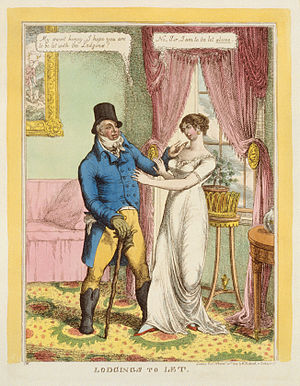
An 1814 engraved cartoon of a double entendre, a figure of speech in which a spoken phrase is devised to be understood in either of two ways. Often the first meaning is straightforward, while the second meaning is less so: often risqué, inappropriate, or ironic. In this cartoon, the man says to the woman, "My sweet honey, I hope you are to be let with the Lodgins!" To this, she replies "No, sir, I am to be let alone." Here, the word "let" can mean either "to leave" or "to rent", so her response can be read to mean either that she wants the man to stop bothering her, or that she is available for a separate fee from the lodging.
Did you know... -
- ... that Filipino fashion designer and Project Runway Philippines judge Rajo Laurel (pictured) has held exhibitions in New York City, San Francisco, Shanghai, Sydney, and Bali?
- ... that the female factory workers featured in the book The Sugar Girls would stuff their turbans with underwear to make them look more fashionable?
- ... that Kate Middleton's wedding dress for her marriage to Prince William was designed by Sarah Burton?
Selected biography -
Susannah Caroline Constantine (born 3 June 1962) is an English former TV fashion journalist, writer, style advisor, television presenter, author and clothes designer. Her second book, What Not to Wear, co-written with her fashion partner Trinny Woodall, won her a British Book Award and sold 670,000 copies.
Constantine was born into a wealthy family; her father was successful in property and shipping sectors. She was privately educated as a child and went on to date David Armstrong-Jones, Viscount Linley during the 1980s. Constantine has been involved in fashion for a long period, originally working in America for Giorgio Armani and then John Galliano in London. She met Trinny Woodall in 1994, with whom she proceeded to co-write a weekly fashion column, Ready to Wear. They founded Ready2shop.com, a dot-com fashion advice business, and wrote their first fashion advice book in 2000, Ready 2 Dress, both of which failed. From there they were commissioned to BBC Two to host the style series, What Not to Wear, from 2001 to 2005. She made regular appearances as a style advisor on The Oprah Winfrey Show and following her success on the shows, she went on to co-host Trinny & Susannah Undress... on ITV in 2006 and Undress the Nation in 2007. (Full article...)
General images
Lua error: No content found on page "Women's beachwear fashion".
More Did you know (auto generated)

- ... that when the Hungarian Arts Fund denied a grant application by Tamás Király for a fashion show, he used the rejection letter as a poster?
- ... that across his thirty-six collections, fashion designer Alexander McQueen contemplated religion, told fairy tales, and criticized the fashion industry?
- ... that before his victory at the 1128 Battle of Axspoele, William Clito ordered his knights to cut their hair and remove opulent clothing as a sign of penance?
- ... that Eenoolooapik fell ill while kayaking through Aberdeen in traditional Inuit clothing?
- ... that clothing physiology is the study of how clothing interacts with the human body and the environment?
- ... that the clothing tags for Alexander McQueen's first collection, Jack the Ripper Stalks His Victims, had McQueen's own hair encased inside?
Selected quote -
Related portals
Topics
Featured content
Categories
Things you can do
- Fill out the red links on Portal:Fashion/Selected anniversaries
Wikimedia
The following Wikimedia Foundation sister projects provide more on this subject:
-
Commons
Free media repository -
Wikibooks
Free textbooks and manuals -
Wikidata
Free knowledge base -
Wikinews
Free-content news -
Wikiquote
Collection of quotations -
Wikisource
Free-content library -
Wikiversity
Free learning tools -
Wiktionary
Dictionary and thesaurus
